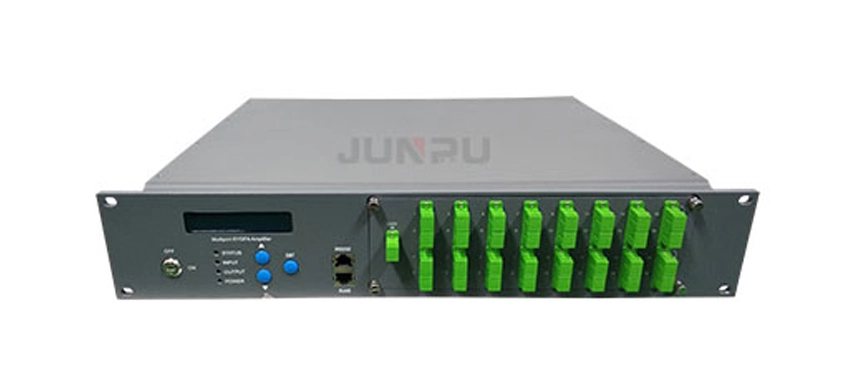
-
Home
-
Products
- Solution
- WHY JUNPU
- Services
- Resources
- News
- Contact Us

Fiber optic communication powers our modern world. It sends data over long distances at high speeds. But signals weaken over distance due to attenuation. Erbium-Doped Fiber Amplifiers (EDFAs) solve this problem. They boost optical signals without converting them to electrical signals. This article explains what EDFAs are, how they work, their uses, and how they differ from Semiconductor Optical Amplifiers (SOAs).
An EDFA is a device that amplifies optical signals in fiber optic systems. It uses a special fiber doped with erbium, a rare earth element. This fiber boosts light signals in the 1550 nm wavelength range, ideal for telecom. EDFAs work in the C-band (1530–1565 nm) and L-band (1565–1600 nm), where signal loss is low. They amplify signals directly, keeping data transmission fast and accurate. Invented in 1987, EDFA became key in the 1990s for long-distance communication.

EDFA operation relies on stimulated emission. A segment of optical fiber is doped with erbium ions. A pump laser, usually at 980 nm or 1480 nm, excites these ions to a higher energy state. When a weak optical signal enters the fiber, it interacts with the excited ions. This causes the ions to release energy as photons, matching the signal’s wavelength. The result is a stronger signal. Key components include the erbium-doped fiber, pump laser, wavelength division multiplexer (WDM), isolators, and optical filters. The WDM combines the signal and pump light. Isolators prevent reflections. Filters reduce noise.
EDFAs are vital for modern communication. They amplify signals without electrical conversion, maintaining speed and bandwidth. This makes them essential for long-distance networks, like undersea cables. EDFAs also support Wavelength Division Multiplexing (WDM), amplifying multiple signals at once. This increases network capacity. Before EDFAs, systems needed complex optical-to-electrical converters. EDFAs simplified networks, cutting costs and boosting efficiency. They are used in telecom, cable TV, and data centers.
Market Validation:
EDFAs dominate 65% of optical amplifier deployments in submarine cables, directly supporting JUNPU's product focus on reliable long-haul solutions. This establishes market credibility when discussing EDFA importance.
Technical Benchmarking:
Our EDFAs meet critical industry thresholds:
30-40dB gain with 4-6dB noise figures
Precise 1550nm (±0.5nm) wavelength stability
DWDM Compatibility:
JUNPU's WDM integration allows simultaneous amplification of 40+ channels - a key selling point to highlight when discussing modern network applications.
Competitive Differentiation:
Performance comparisons show EDFAs outperform SOAs by:
50% lower noise (4-6dB vs 8-12dB)
3x greater gain potential (40dB vs 13dB)
EDFAs have many applications in optical communication. They are used as booster amplifiers, in-line amplifiers, and pre-amplifiers. Booster amplifiers increase signal power at the transmitter for long-distance transmission. In-line amplifiers restore signal strength in the middle of a fiber link. Pre-amplifiers boost weak signals before they reach the receiver. EDFAs are critical in Dense Wavelength Division Multiplexing (DWDM) systems, where they amplify multiple channels simultaneously. This supports high-capacity networks. They also power cable TV networks, ensuring signals reach wide areas. In data centers, EDFAs maintain signal strength for high-speed data transfer. Their ability to handle long spans—up to 100 km—makes them ideal for global communication networks, including submarine cables like the TPC-5CN network, operational since 1996.
EDFAs and Semiconductor Optical Amplifiers (SOAs) both amplify optical signals, but they differ in design and performance. EDFAs use erbium-doped fiber as the gain medium, while SOAs use a semiconductor material. EDFAs operate in the 1530–1565 nm range, ideal for telecom’s low-loss window. SOAs work across a broader range, including 1300 nm, but with higher noise. EDFAs offer high gain (15–40 dB) and low noise (4–6 dB), making them better for long-distance systems. SOAs have lower gain and higher noise, limiting their use to shorter distances. EDFAs are larger and need pump lasers, while SOAs are compact and electrically driven. EDFAs excel in WDM systems due to their wide bandwidth, while SOAs are better for single-channel or compact applications, like metro networks.
EDFAs offer clear benefits. They provide high-gain, amplifying signals up to 40 dB. Their low noise figure ensures signal quality. They work in the 1550 nm range, matching the lowest-loss window of optical fibers. EDFAs also have a wide bandwidth (20–40 nm), supporting multiple channels in WDM systems. Their coupling efficiency with fibers is excellent, with losses below 0.1 dB. However, EDFAs have limits. They cannot amplify wavelengths below 1525 nm, restricting their use. High bandwidth demands can strain EDFAs, as they may not scale well for ultra-high-speed systems. They also require precise control of pump power and signal input to avoid distortion. Compared to alternatives like Raman amplifiers, EDFAs may have narrower bandwidths.
EDFAs are key to today’s high-capacity networks. They enable long-haul communication, supporting global internet and cloud services. In DWDM systems, EDFAs amplify multiple wavelengths, fixing issues like insertion loss and chromatic dispersion. They are used in smart city networks, IoT systems, and industrial automation. For example, in cable TV networks, EDFAs act as power amplifiers to cover large areas. In data centers, they ensure reliable data transfer over extended distances. EDFAs also support 50G PON and Combo PON technologies, integrating high-speed services like GPON and XGS-PON. Their role in submarine cables highlights their importance for global connectivity. As networks grow, EDFAs remain a cornerstone, balancing cost, efficiency, and performance.
EDFAs are a game-changer in optical communication. They amplify signals efficiently, supporting long-distance, high-capacity networks. Their ability to work with WDM systems makes them ideal for modern telecom, cable TV, and data centers. While they have limitations, like wavelength restrictions, their high gain and low noise make them superior to SOAs for many applications. As demand for data grows, EDFAs will continue to drive fast, reliable communication. Understanding their role helps us appreciate the technology behind our connected world.
 Call us on:
Call us on:  Email Us:
Email Us:  Wanhua Science and Technology Park, No. 528, Shunfeng Road, Donghu Street, Linping District, Hangzhou City, Zhejiang Province
Wanhua Science and Technology Park, No. 528, Shunfeng Road, Donghu Street, Linping District, Hangzhou City, Zhejiang Province